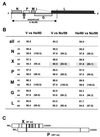Isolation and characterization of a new subtype of Borna disease virus
- PMID: 10823873
- PMCID: PMC112053
- DOI: 10.1128/jvi.74.12.5655-5658.2000
Isolation and characterization of a new subtype of Borna disease virus
Abstract
Borna disease virus (BDV), the causative agent of severe meningoencephalitis in a wide variety of animal species, has been considered to be genetically invariable and to form a single type within the genus Bornavirus of the family Bornaviridae. BDV infections are of particular interest, because for the first time a virus infection appears to be linked to human psychiatric disorders. We now describe a new subtype of BDV isolated from a horse which was euthanatized due to severe, incurable neurological disease. The nucleotide sequence of this new strain, named No/98, differs from the reference strains by more than 15%, and the subtype is difficult to detect by standard reverse transcriptase PCR protocols. The nucleotide exchanges of the novel BDV isolate have surprisingly little effect on the primary structures of most viral proteins, with the notable exception of the X protein (p10), which is only 81% identical to its counterpart in reference strains. Our data indicate that the genome of BDV is far more variable than previously assumed and that naturally occurring subtypes may escape detection by currently used diagnostic assays.
Figures




References
-
- Bode L, Dürrwald R, Rantam F A, Ferszt R, Ludwig H. First isolates of infectious human Borna disease virus from patients with mood disorders. Mol Psychiatry. 1996;1:200–212. - PubMed
-
- Bode L, Zimmermann W, Ferszt R, Steinbach F, Ludwig H. Borna disease virus genome transcribed and expressed in psychiatric patients. Nat Med. 1995;1:232–236. - PubMed
-
- de la Torre J C, Bode L, Dürrwald R, Cubitt B, Ludwig H. Sequence characterization of human Borna disease virus. Virus Res. 1996;44:33–44. - PubMed
Publication types
MeSH terms
Substances
Associated data
- Actions
LinkOut - more resources
Full Text Sources
Other Literature Sources

